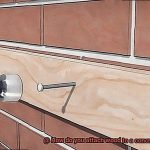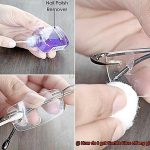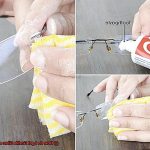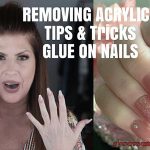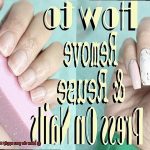Imagine this: You’re knee-deep in a DIY project, feeling like a pro, when disaster strikes. Your nimble fingers are suddenly glued together by the unyielding grip of dried Gorilla Glue. Panic sets in as you frantically search for an escape plan. But fear not, fellow DIY enthusiasts. Today, we embark on a journey into the enchanting world of dissolving dried Gorilla Glue.
Dried Gorilla Glue is notorious for its unbeatable bond, making it the adhesive of choice for craftsmen and DIYers alike. However, accidents happen, and sometimes we need to break free from its clutches. In this all-inclusive guide, we unveil the secret techniques to liberate ourselves from the tyranny of dried Gorilla Glue.
First things first – brace yourself as we navigate through the maze of solvents. Discover the magical powers of chemicals that possess the ability to unravel even the most stubborn bonds created by this mischievous glue. From acetone to isopropyl alcohol, we delve deep into each solvent’s strengths and weaknesses, empowering you to choose the perfect solution for your predicament.
But wait – there’s more. We also explore the wonders of mechanical intervention. Witness firsthand how scrapers, sandpaper, and sheer determination can conquer hardened glue with ease. Prepare to be amazed as human ingenuity triumphs over sticky situations.
Last but not least, we take a plunge into the art of prevention. Learn invaluable tips and tricks on how to avoid these sticky mishaps altogether. From mastering proper adhesive application techniques to storing your glue like a pro, we’ve got you covered.
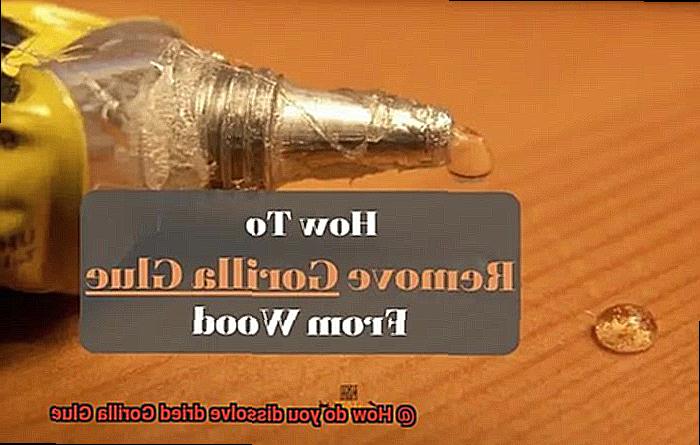
So, whether you find yourself stuck in a gluey mess or simply have an insatiable curiosity about adhesives’ mysterious ways, join us on this epic quest as we unravel the secrets of dissolving dried Gorilla Glue. Adventure awaits, my friends.
Safety Guidelines
Contents
Unlocking the full potential of Gorilla Glue requires not only skill but also a commitment to safety. This adhesive, renowned for its remarkable bonding capabilities, demands careful handling to ensure both effective usage and personal well-being. In this article, we present a comprehensive guide on safety guidelines that should be followed when working with Gorilla Glue responsibly.
Personal Protective Gear (PPE)
Prioritize your safety by donning the necessary protective gear when handling Gorilla Glue. Safety goggles and gloves are essential armor, shielding you from direct contact and preventing potential eye injuries.
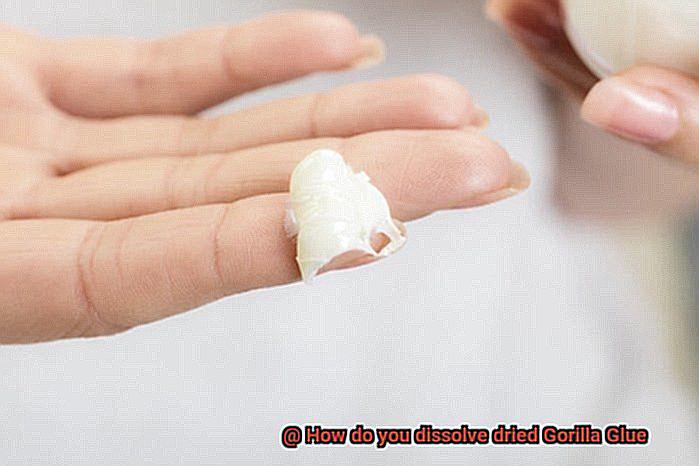
Breathing Space
Don’t let the fumes take your breath away. Ensure your workspace boasts ample ventilation to ward off any unwanted inhalation of glue fumes. Open windows, deploy fans, or even venture outside to guarantee the free flow of fresh air during usage.
Fire Fear
Beware the fiery dance. Gorilla Glue is highly flammable, making it crucial to banish it from open flames, sparks, and all sources of ignition. Store this potent adhesive in a secure location, far from the clutches of heat.
Skin SOS
Accidental skin contact? Act swiftly. Rush to wash the affected area with soap and water immediately. Avoid resorting to solvents or harsh chemicals that might exacerbate the situation. Seek medical attention if irritation persists or any adverse reactions arise.
Eye Emergency
A gluey encounter with your eyes? Panic not. Flush them profusely with clean water for at least 15 minutes without delay. Swiftly seeking medical attention is crucial to prevent potential damage or complications.
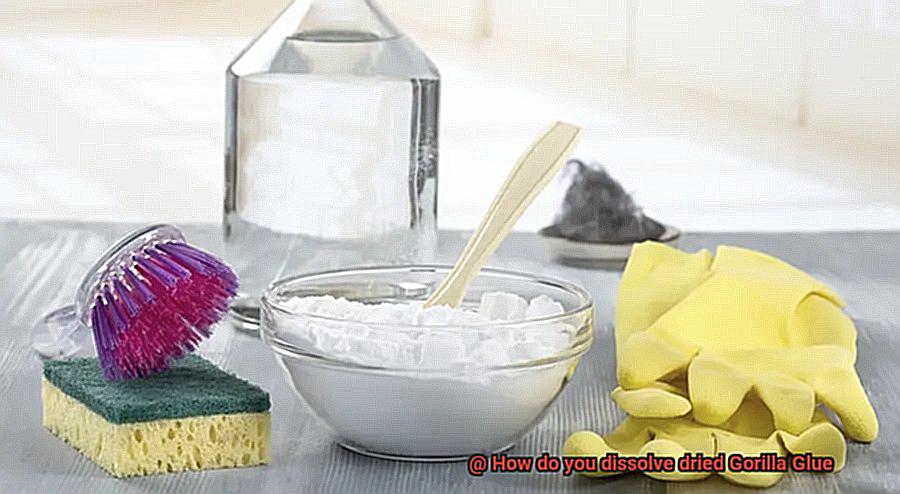
Section 6: No Ingestion Invitation
Remember, tasting is not an option. Never ingest Gorilla Glue, as it poses serious health risks. In case of accidental ingestion, promptly seek medical assistance or contact a poison control center.
Section 7: Storage Safe haven
Preserve Gorilla Glue’s potency by storing it in a cool, dry place, far from the clutches of direct sunlight. Ensure this adhesive treasure is out of reach from curious little hands and inquisitive pets. Keep the container tightly sealed to prevent spills and inadvertent exposure.
Acetone Method
We’ve all faced the sticky nightmare of dried Gorilla Glue, but fear not. The acetone method is here to save the day. This guide will take you on a thrilling journey through the power of acetone, providing you with the ultimate solution to dissolve dried Gorilla Glue. So put on your gloves and get ready to conquer any sticky situation.

Gathering the Materials:
Before we embark on this daring mission, let’s gather the necessary materials. Arm yourself with a bottle of pure acetone, a trusty cloth or sponge, and protective gloves. Safety first, my friends.
Step 1: Embrace Your Heroic Persona
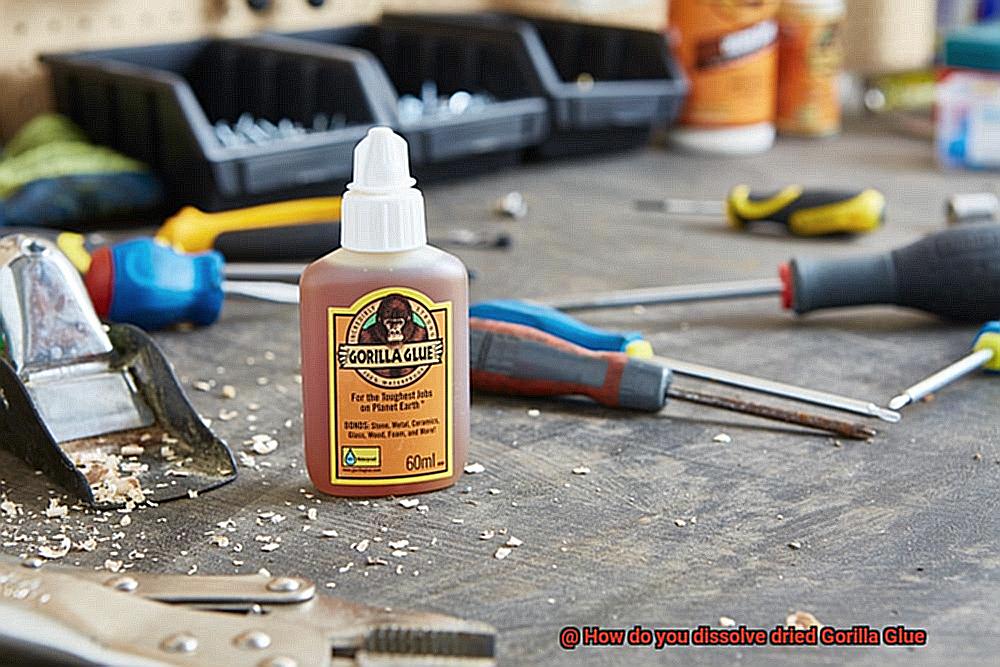
Don your protective gloves, transforming into a fearless DIY hero ready to face any chemical challenge. Safety is the cape that shields us from harm.
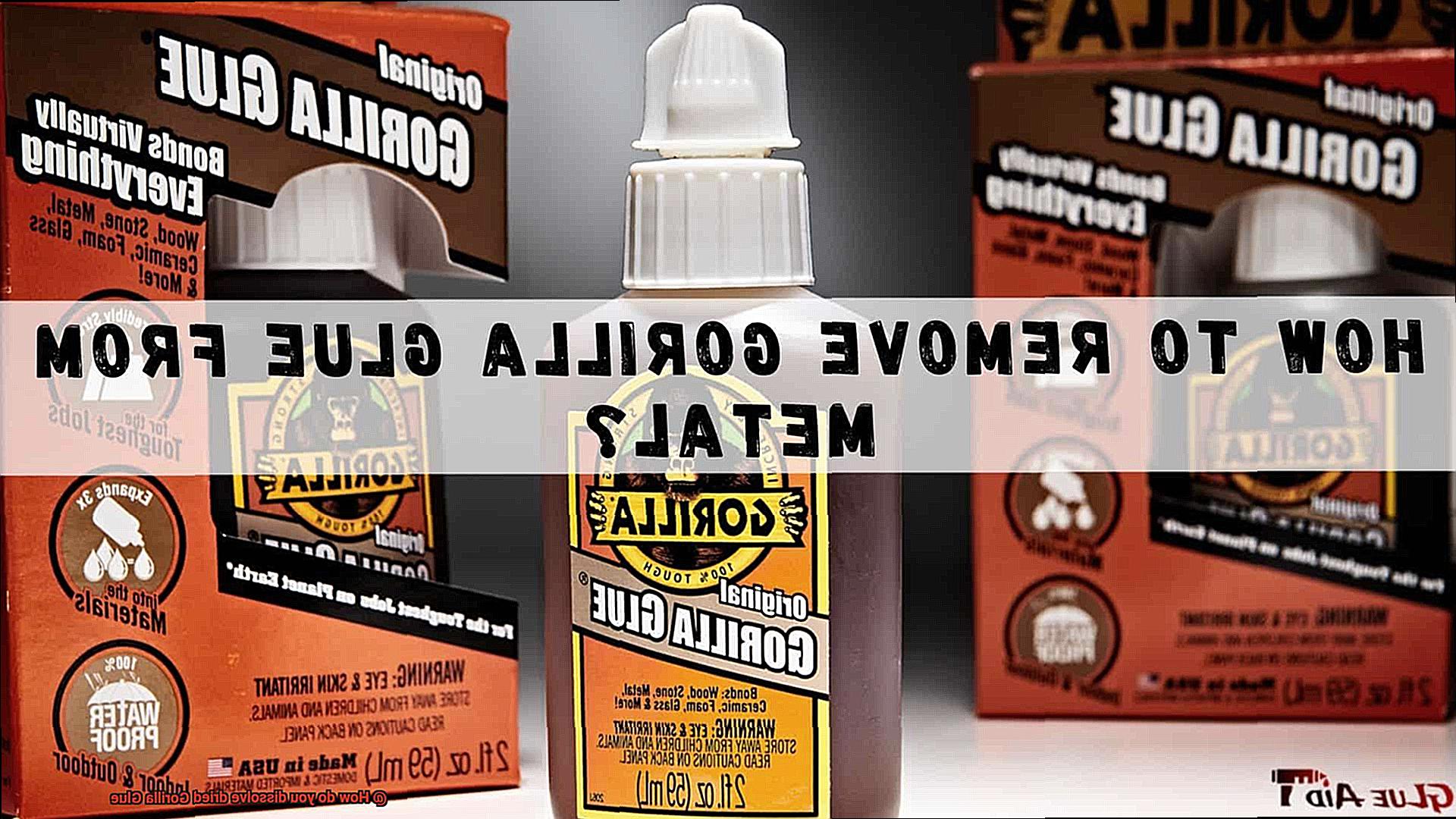
Step 2: Rev Up the Magic
Now it’s time to unleash the magic of acetone onto that stubborn dried Gorilla Glue. Dampen your cloth or sponge with a small amount of acetone and let the enchantment begin. With gentle circular motions, watch as the acetone breaks down those unyielding adhesive bonds.
Pro Tip: Prepare for battle in a well-ventilated area or equip yourself with a respirator mask if needed. The potent odor of acetone may not be for the faint of heart.
Step 3: Witness the Power Unleashed
As you persistently rub the dried Gorilla Glue with your acetone-soaked cloth or sponge, marvel at the glue’s surrender. Softening and breaking apart, it succumbs to the mighty force of acetone. To remove this defeated glue from the surface, wield your scraping tool or gloved fingers.
Step 4: Embrace Tenacity
Sometimes victory requires multiple attempts. If the dried Gorilla Glue persists, fear not. Repeat the acetone method until all traces of the glue have been banished. Remember, persistence is the key to triumph.
Step 5: Restore Purity
With the dried Gorilla Glue dissolved and defeated, it’s time to cleanse the surface of any lingering residue. Take a clean cloth dampened with water and wipe away any remnants or traces of acetone. This final act ensures that your surface is pristine and ready for its next adventure.
Isopropyl Alcohol Method
Today, we embark on a quest to conquer the stickiness of dried Gorilla Glue using the mighty Isopropyl Alcohol Method. Prepare to unleash the power of this colorless liquid and bid farewell to sticky nightmares. So, don your cape and let’s dive into the fascinating world of dissolving dried Gorilla Glue.
Isopropyl Alcohol: The Trusty Sidekick:

In our arsenal, we have isopropyl alcohol, also known as rubbing alcohol. This powerful solvent, with its strong odor, can be easily obtained at drugstores or supermarkets. It is the hero we need to defeat that stubborn adhesive.
The Power of Concentration:
To maximize the potency of isopropyl alcohol, we must wield a high concentration. Aim for 90% or higher to ensure the glue’s resistance is effectively softened and dissolved. With this level of concentration, victory is within reach.
The Dissolving Process:
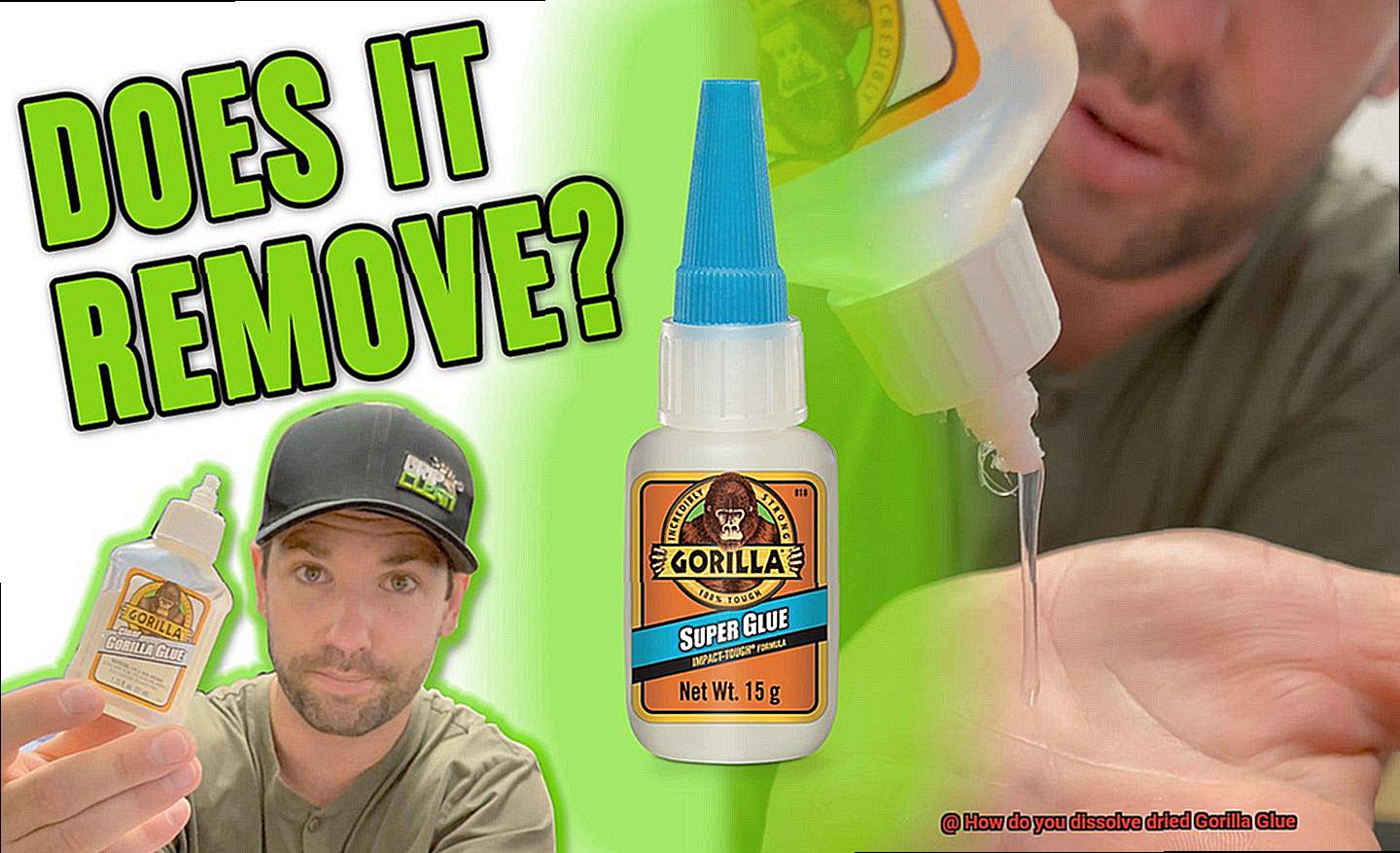
Now, brave warriors, it is time to take action. Begin by pouring a small amount of isopropyl alcohol onto the dried Gorilla Glue. Watch in awe as the alcohol performs its magic, tenderly breaking down and dissolving the glue.
Grant it Time:
Patience, dear heroes. Allow the isopropyl alcohol a few minutes to work its way into every nook and cranny. This extra time ensures deep penetration and further loosening of the adhesive bond. The longer you wait, the smoother your triumph will be.
Gently Scrub Away:
Once the alcohol has exerted its influence, seize a soft cloth or sponge and gently scrub the glue-covered area. Behold as the softened adhesive effortlessly releases its grip. Remember, be gentle yet persistent in your scrubbing.
Tackling Stubborn Spots:
Occasionally, stubborn and hard-to-reach areas test our mettle. Fear not. Arm yourself with a toothbrush or a cotton swab soaked in isopropyl alcohol and face these spots head-on. Their resistance will crumble in the face of your unwavering determination.
Safety Precautions:
In every heroic endeavor, safety takes precedence. When employing isopropyl alcohol, ensure you work in a well-ventilated area. Take care to shield your eyes from contact and avoid prolonged exposure to your skin.
Warm Soapy Water Method
If you’ve ever battled the relentless grip of dried Gorilla Glue, fear not. Today, we unveil a simple yet potent weapon in your arsenal – the Warm Soapy Water Method. Prepare to witness the destruction of this stubborn adhesive as we dive into the depths of this epic battle.
Unveiling the Magic:
Let us unravel the secret behind the Warm Soapy Water Method, a mysterious blend of warm water and soap. Behold as warm water delicately softens the glue’s hold, while soap valiantly shatters its chemical bonds, leaving it defenseless against your might.
Assemble Your Forces:
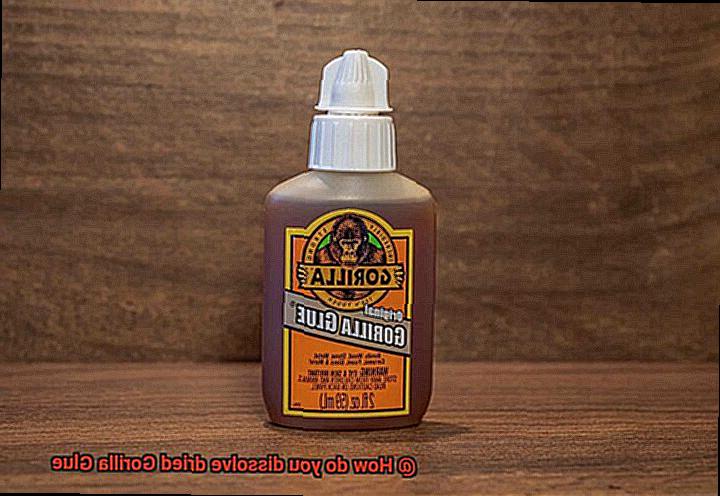
Gather your supplies, brave warriors. Arm yourself with warm water, the noble mild dish soap, a trusty sponge or cloth for maximum impact, and if needed, a scrub brush to penetrate even the most hidden corners.
A Step-by-Step Conquest:
Prepare for action. Begin by moistening the dried Gorilla Glue with warm water, weakening its tenacious grip on your surfaces. Next, unleash the power of mild dish soap upon the affected area, gently massaging it into the glue’s core using a sponge or cloth. Allow this soapy elixir to work its magic for 10-15 minutes, penetrating deep and softening the adhesive’s resolve.
Safety First:
As heroes, we must prioritize our safety. Don your protective gloves and choose a well-ventilated battleground to shield yourself from any potential irritants lurking within Gorilla Glue or dish soap. Stay vigilant like true champions.
Secrets to Enhance Your Victory:
In our quest for triumph, additional wisdom can prove invaluable. For those stubborn spots that refuse to yield, equip yourself with a toothbrush or cotton swab soaked in soapy water. Watch as they cower before your unwavering determination. And remember, if the glue persists, do not despair. Repeat the process until you achieve the glorious victory you seek.
Mechanical Methods
Today, we shall embark on a journey into the realm of mechanical methods, where our hands become the formidable weapons that dissolve this adhesive menace. Join me as we explore a variety of techniques that will empower you to emerge victorious in this epic struggle.
Scraping:
Imagine yourself wielding a trusty scraper or putty knife as you enter the battlefield. This method proves most effective when the glue has not fully bonded or when dealing with thin layers. With precision and determination, gently scrape off the dried glue from the surface, chipping away at its defenses until triumph is yours. Remember to exercise caution to avoid inflicting harm upon the material beneath.
Sanding:
Ah, behold the art of sanding – a technique that proves particularly useful when battling Gorilla Glue on wooden surfaces. Equip yourself with sandpaper or a sanding block, and let the sanding commence. With each stroke, you gradually wear down the dried glue, unveiling the pristine beauty hidden beneath. Take care not to go overboard and damage the material; precision is key.
Applying Heat:
For those who crave a more fiery approach, heat can be your steadfast ally in dissolving dried Gorilla Glue. Harness the power of a heat gun or hairdryer set to its highest setting, and let the battle begin. The intense heat softens the glue, weakening its unwavering hold and rendering it easier to remove. However, tread cautiously, my friends, for excessive heat may cause harm to certain surfaces. Test this method on a small area before unleashing it on a larger scale.
Specialized Adhesive Removers:
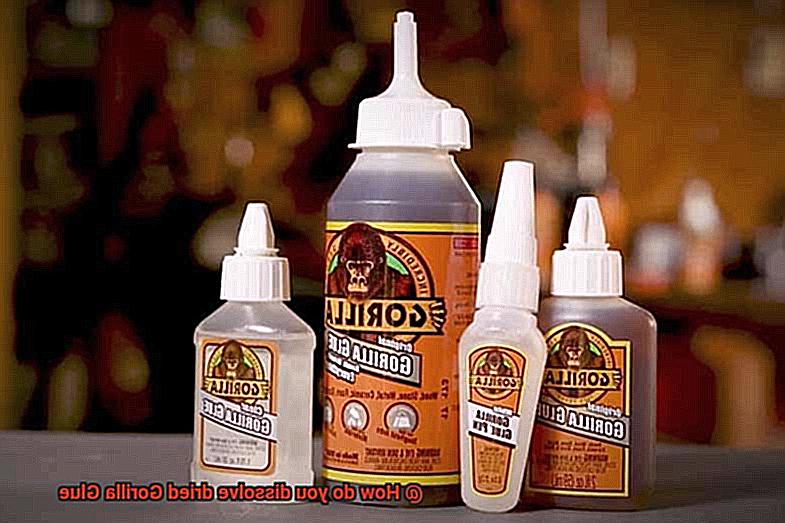
Behold, warriors. There exists a range of specialized adhesive removers, specifically crafted to combat the stubborn grip of dried Gorilla Glue. These formidable concoctions come in gel or liquid forms, utilizing mechanical action to break down the glue’s bond with the surface. Simply apply the remover directly to the dried glue, allowing it to work its magic for a designated time, then scrape or wipe it away. Victory shall be yours.
Factors Affecting Glue Dissolution
Prepare yourselves, brave warriors, as we embark on a perilous journey to conquer the indomitable dried Gorilla Glue. In this chapter, we shall uncover the secrets behind the factors that influence the dissolution of this formidable adhesive. Arm yourselves with knowledge and let us forge ahead to triumph over stubborn glue.
Temperature: The Heat of Battle
Picture yourself in an epic battle against dried Gorilla Glue. Would you choose a scorching desert or a freezing tundra as your battlefield? Temperature holds the key. Higher temperatures ignite a fiery acceleration in the glue dissolution process by intensifying molecular movement. Solvents can effortlessly infiltrate the glue’s stronghold. Conversely, colder temperatures act as icy barriers, slowing down or even thwarting glue removal. Remember, when selecting a solvent and determining the required time for effective dissolution, temperature is a vital consideration.
Solvent Selection: Choosing Your Potent Elixir
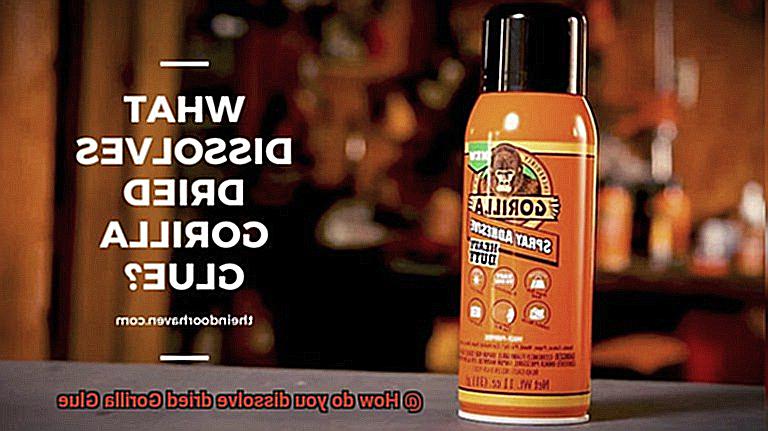
In our arsenal against dried Gorilla Glue, solvents play a pivotal role. Each solvent possesses unique chemical properties that interact distinctively with the adhesive’s composition. Acetone and isopropyl alcohol, renowned for their potent solvency power, are commonly wielded in this battle. However, not all solvents can vanquish all types of glue. Beware. Some solvents may inflict harm or discoloration upon certain surfaces. Test your chosen solvent on a discreet area first to ensure compatibility and protect against potential damage.
Surface Compatibility: The Right Match Matters
Just as in any legendary duel, compatibility reigns supreme. The surface to which dried Gorilla Glue clings exerts a mighty influence on its dissolution. Varying materials possess differing chemical compositions, leading to diverse reactions when exposed to solvents. For instance, while acetone may effectively dissolve the adhesive on metal or glass surfaces, it might prove detrimental to wood or plastic. Be astute in evaluating material compatibility and select a solvent that upholds the integrity of your chosen surface.
Pros and Cons of Different Methods
Welcome, fearless warriors of the adhesive realm. Today, we embark on a journey to uncover the pros and cons of various methods to dissolve the mighty dried Gorilla Glue. Brace yourselves for a thrilling exploration of knowledge.
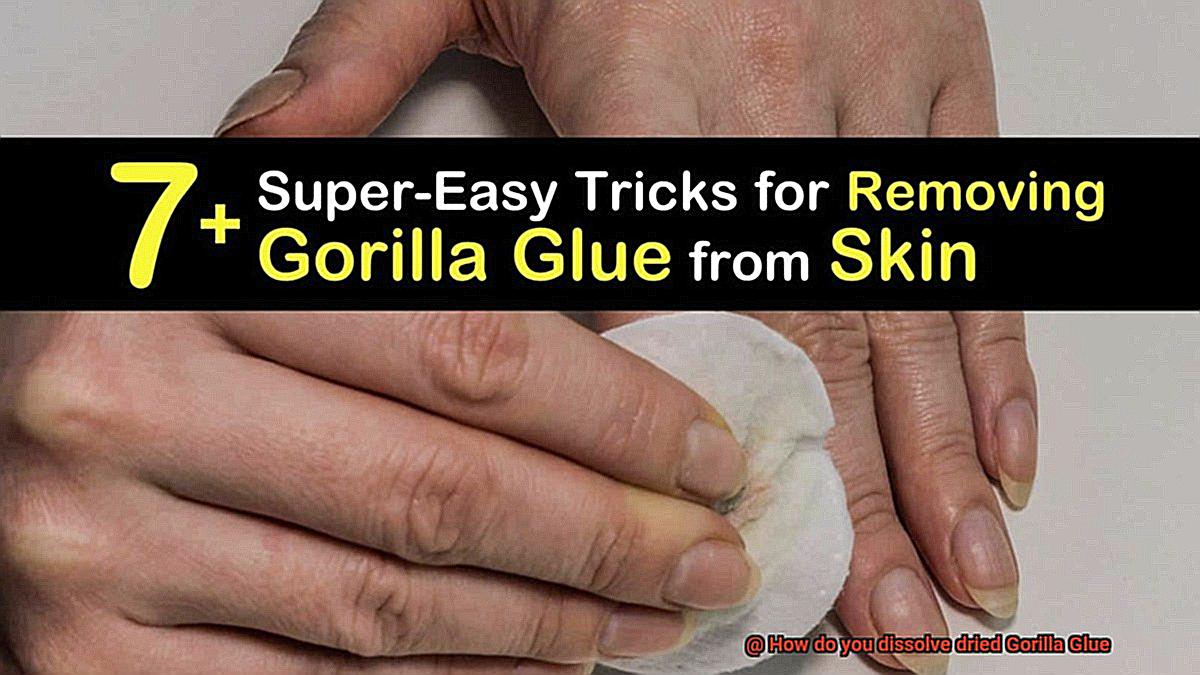
Acetone: The Swift and Mighty
Pros:
- Acetone, the champion among solvents, is a readily available and affordable option that swiftly and efficiently dissolves dried Gorilla Glue.
- DIY enthusiasts rejoice, for this powerful solvent works like magic, making it a popular choice.
- With its incredible effectiveness in breaking down the adhesive bond, removing the glue becomes a breeze.
Cons:
- Beware, for acetone is not to be trifled with. This strong chemical demands caution, as it can cause harm if it comes into contact with your precious skin or eyes. Protective gloves and goggles are an absolute must.
- While acetone is generally safe for most surfaces, it’s wise to test it on a small area first to ensure compatibility.
Isopropyl Alcohol: The Gentle Yet Effective
Pros:
- Isopropyl alcohol, also known as rubbing alcohol, offers a kinder approach to dissolve dried Gorilla Glue while still being highly effective.
- Widely available and relatively safe to use, this solvent is a reliable option for many.
- Embrace the natural solution. Isopropyl alcohol works its wonders on most surfaces and satisfies those who prefer non-chemical methods.
Cons:
- Patience is key with isopropyl alcohol. It may take a bit longer to dissolve the glue compared to its swift counterpart, acetone.
- Even though it’s generally considered safe for most surfaces, testing it on a small area beforehand is still recommended.
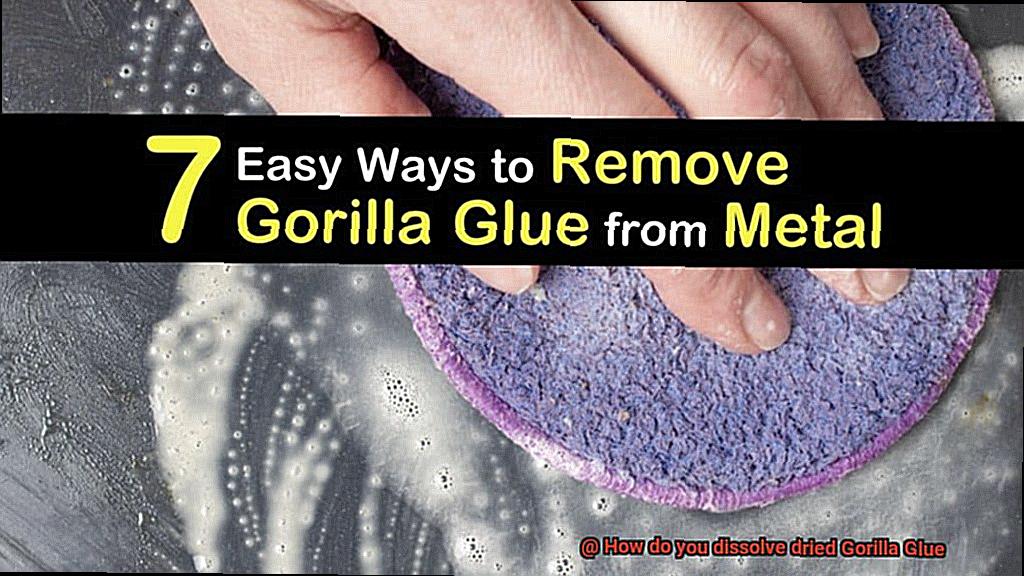
White Vinegar: The Natural Alternative
Pros:
- Nature enthusiasts rejoice. White vinegar presents a safe and natural alternative for dissolving dried Gorilla Glue.
- Harnessing the power of acetic acid, vinegar gracefully breaks down the adhesive bond.
Cons:
- While vinegar may not be as quick as chemical solvents like acetone or isopropyl alcohol, it offers a safer option for those seeking natural solutions.
- Keep in mind that vinegar may not be as effective on tougher or larger glue deposits, so choose wisely.
Tips for Successful Glue Dissolution
Removing dried glue, especially Gorilla Glue, can be a challenging task. However, with the right tips and techniques, you can effectively dissolve Gorilla Glue and restore surfaces to their original condition. This article will explore various methods and precautions to ensure successful glue dissolution. Remember to prioritize safety by wearing protective gloves and working in a well-ventilated area.
Acetone: Unlocking the Power of Solvents
Acetone, commonly found in nail polish remover, is a powerful solvent that can effectively break down the adhesive properties of Gorilla Glue. To use acetone, generously apply it onto the affected area and allow it to sit for a few minutes. Then, using a cloth or sponge, gently rub the glue until it starts to dissolve. It is important to test acetone on a small, inconspicuous area first, as it can be quite strong and may cause damage to certain surfaces.
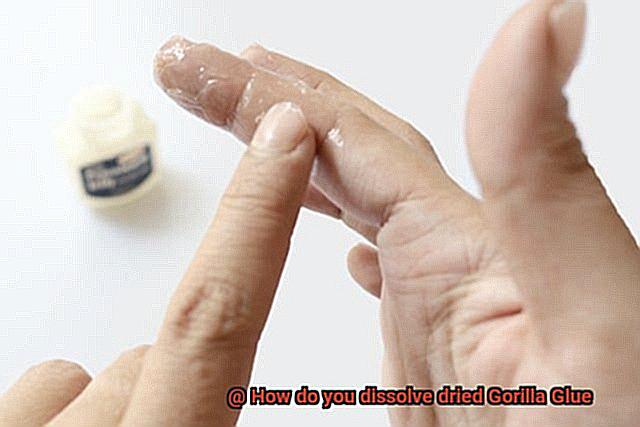
Warm Water Soak: Gentle and Effective Dissolution
For non-porous surfaces like glass or metal, a warm water soak can work wonders in dissolving dried Gorilla Glue. Fill a bowl or basin with warm water and immerse the affected object or surface in it for approximately 30 minutes to an hour. The warm water will soften the glue, making it easier to remove. After soaking, use a scraper or your fingers to gently peel off the dissolved glue. This method is particularly effective for larger glue stains.
Vinegar: Nature’s Dissolver
Vinegar is not only an essential ingredient in cooking but also a natural solution for dissolving dried Gorilla Glue. Soak a cloth or sponge in vinegar and apply it directly onto the dried glue. Allow the vinegar to sit for a few minutes before attempting to remove the glue. For stubborn or larger glue stains, you may need to repeat this process multiple times. The acidic properties of vinegar help break down the adhesive bonds of the glue, making it easier to remove.

Rubbing Alcohol: An Alternative Solvent
If you don’t have acetone on hand, rubbing alcohol, also known as isopropyl alcohol, can be used as an alternative solvent for dissolving dried Gorilla Glue. Moisten a cloth or cotton ball with rubbing alcohol and dab it onto the glue. Let it sit for a few minutes before gently rubbing or scraping off the dissolved glue. Just like with other solvents, test rubbing alcohol on a small area first to ensure it does not damage the surface being treated.
Conclusion
When it comes to dealing with dried Gorilla Glue, finding a solution can be quite the challenge. But fear not, for there are methods that can help dissolve this stubborn adhesive. With a little bit of know-how and some household items, you’ll be able to tackle this sticky situation head-on.
One option is to use acetone, a powerful solvent that can break down Gorilla Glue. Simply soak a cloth or cotton ball in acetone and apply it directly to the dried glue. Let it sit for a few minutes, allowing the acetone to penetrate and loosen the adhesive. Then, gently scrape away the dissolved glue with a plastic scraper or your fingernail.
Another effective method involves using isopropyl alcohol. Dampen a cloth with the alcohol and place it on top of the dried glue. Leave it there for about 10 minutes, giving the alcohol enough time to soften the adhesive. Afterward, use a plastic scraper to carefully remove the softened glue from the surface.
For those who prefer natural alternatives, vinegar can also do the trick. Soak a cloth in white vinegar and place it over the dried Gorilla Glue. Allow it to sit for at least an hour, letting the vinegar work its magic on the adhesive. Once softened, you can scrape off the glue using a plastic scraper or your fingernail.
It’s important to note that when using any of these methods, caution should be exercised. Always work in a well-ventilated area and wear protective gloves to avoid skin irritation. Additionally, test any solvent on a small inconspicuous area first to ensure it doesn’t damage or discolor your surface.
In conclusion, while dried Gorilla Glue may seem like an insurmountable challenge, there are effective ways to dissolve it. Whether you choose acetone, isopropyl alcohol, or vinegar as your weapon of choice, with patience and the right tools, you can conquer this sticky situation.


